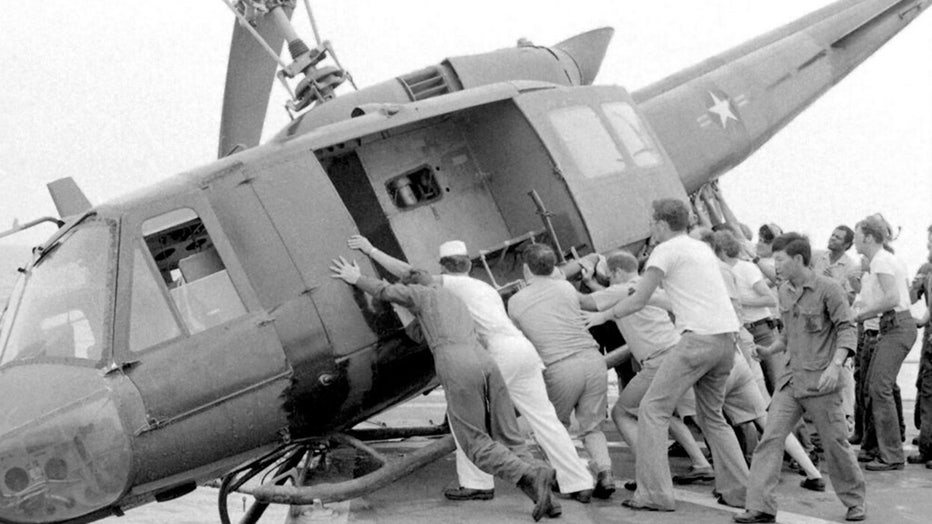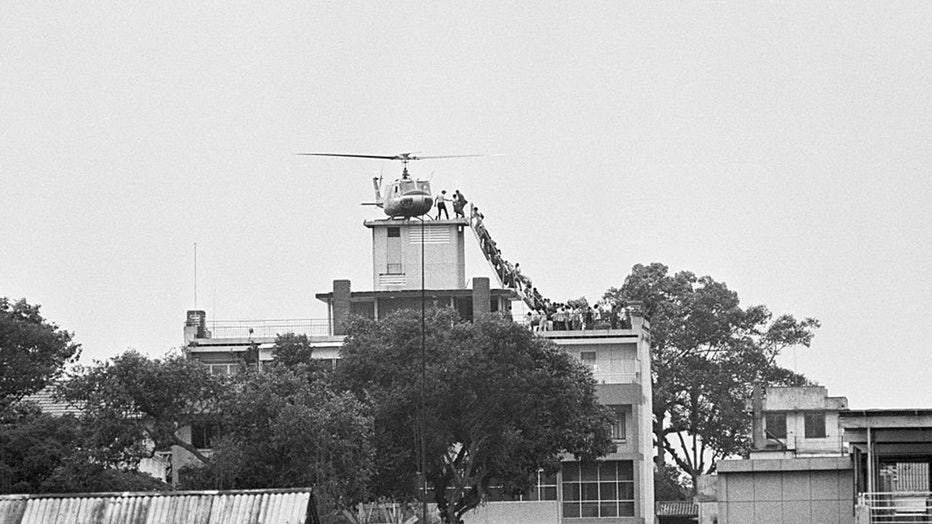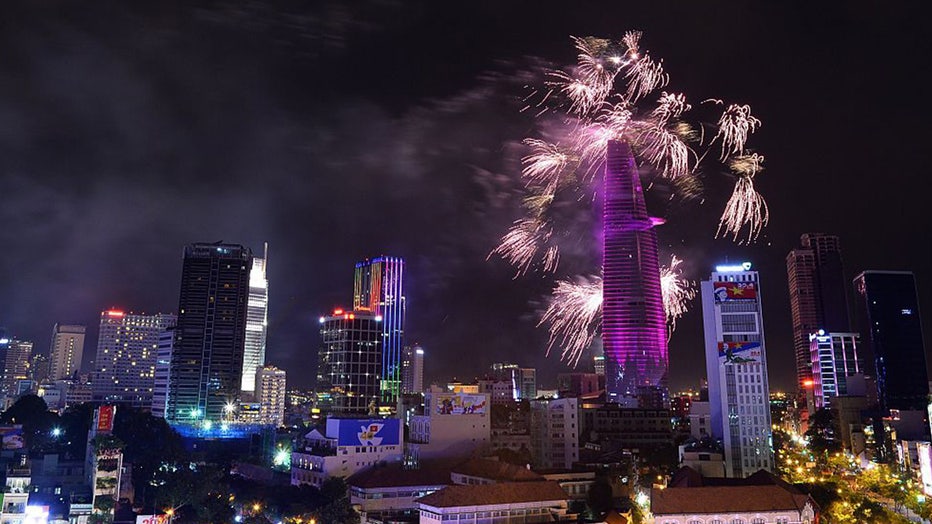The autumn of Saigon on April 30, 1975, marked the top of the Vietnam Struggle.
The give up of South Vietnam ended the decades-long battle and signaled the reunification of North and South Vietnam. Saigon was renamed Ho Chi Minh Metropolis in honor of communist chief Ho Chi Minh.
Check out some stats on the battle and the way it impacted the world 50 years later.
What occurred?
The backstory:
On April 30, 1975, North Vietnamese troops took over Saigon, then the capital of South Vietnam. They crashed by way of the gates of the presidential palace and hoisted the communist flag, marking the top of the Vietnam Struggle.
As North Vietnamese troops shelled Saigon’s Tan Son Njut Air Base, then U.S. Ambassador Graham Martin ordered the evacuation of Saigon, in line with the Nationwide Museum of American Diplomacy.
To sign all People that it was time to evacuate, Armed Forces Radio began taking part in “White Christmas” on repeat.
Evacuation situations, nonetheless, have been lower than favorable.
Dig deeper:
Since North Vietnamese troops shelled the airport, it was unusable. Individuals have been pressured to resort to utilizing helicopters.
Little by little, evacuees have been transported from land to U.S. Navy ships 40 miles away within the South China Sea.
Tens of hundreds of individuals, together with American and Vietnamese civilians, clamored outdoors the American embassy gates, hoping to flee the North Vietnamese troops that have been closing in.
FILE – Determined South Vietnamese residents attempt to scale the partitions of the American Embassy in a useless try to flee Saigon and avancing North Vietnamese troops. (nik wheeler/Corbis through Getty Photos)
To make room for folks aboard ships, helicopters have been thrown overboard to lighten the load.

FILE – The Fall of Saigon was the seize of Saigon, the capital of South Vietnam, by the Individuals’s Military of Vietnam and the Nationwide Liberation Entrance of South Vietnam (often known as the Viet Cong) on April 30, 1975. (Photos From Historical past/Common Im
In their very own phrases
Years after American troops and civilians left Vietnam, reporters, correspondents and diplomats shared their experiences, fears and disgrace when evacuating Saigon in 1975.
What they’re saying:
Robert Weiner, a Vietnam correspondent from 1985, stated on the day Saigon fell, he felt a way of happiness but additionally disgrace when evacuations have been ordered.
“The one method People may go away Vietnam was finally beating hundreds of Vietnamese off the gates of the embassy, off the helicopter,” Weiner stated.
Robert Hedrix, a civilian pilot who was helping with evacuations in the course of the fall of Saigon, recalled how households tried to pile into the evacuating helicopters.
“Two of them that I typically marvel about have been about 3-week-old twins {that a} mom handed me. I used to be holding them like a few fish by the tail. Handed them again to some folks behind me, however, you already know, I can nonetheless see their eyes,” Hendrix stated.
“The North Vietnamese got here south in a wave. It was unbelievable how shortly issues occurred,” Maj. James Kean, an American embassy Marine commander, stated.
When did the battle begin?
The U.S. turned concerned within the Vietnam Struggle starting in 1954, however the battle within the area had stretched again for many years.
Timeline:
Right here’s what led as much as the battle in Vietnam.
1887: France colonizes elements of Southeast Asia, calling it French Indochina, which included Vietnam.
1930: Ho Chi Minh based the Indochinese Communist Social gathering.
1940: Months after Nazi Germany invaded France, Japanese troops invaded and occupied Vietnam.
1941: Minh and his fellow communists create the League for the Independence of Vietnam, referred to as Viet Minh. The group aimed to withstand the French and Japanese occupation of their nation.
1945: Japanese troops perform a coup and overthrow French authorities and declare Vietnam unbiased, however a couple of months later, after being defeated in World Struggle II, Japan leaves the nation.
1946: After rejecting a proposal to offer Vietnam restricted self-government, Viet Minh begins a guerrilla battle in opposition to the French.
1949: France established Emperor Bao Dai as the pinnacle of Vietnam.
1950: After getting backed by the Soviet Union and the newly fashioned Communist China, The U.S. identifies Viet Minh as a communist risk.
1954: Viet Minh defeats French troops within the Battle of Dien Bien Phu, ending centuries of French rule in Vietnam. The Geneva Accords formally establishes North and South Vietnam.
Regardless of the treaty, the final word purpose of each the North and South was to unify Vietnam, however every had a distinct thought of what that regarded like, and thus the civil battle continued.
The preventing between North and South solely intensified because of the Chilly Struggle between the U.S. and the Soviet Union.
What’s extra, throughout President John F. Kennedy’s time period, the “Domino Principle” was coined, which prompt that if one Southeast Asian nation fell to communism, it might have a domino impact and different nations would observe.
This concern prompted Kennedy to ship extra U.S. troops to Vietnam, additional establishing America’s position within the battle regardless of protests again at dwelling in opposition to it.
Infighting between the Viet Cong (Vietnamese Communist) and the South went on for years and ultimately resulted in April 1975.

FILE – A CIA worker (most likely O.B. Harnage) helps Vietnamese evacuees onto an Air America helicopter from the highest of twenty-two Gia Lengthy Avenue, a half mile from the U.S. Embassy. (Getty Photos)
Impression of the Vietnam Struggle within the US
Large image view:
The Vietnam Struggle enormously impacted U.S. society and tradition.
Along side Watergate and the Vietnam Struggle, People’ belief within the federal authorities slumped.
President Richard Nixon, the final president to supervise the battle, had ordered a secret bombing marketing campaign in Cambodia, main Congress to move the Struggle Powers Decision.
The decision restricts the president’s skill to ship troops into prolonged fight with out congressional approval, in line with the Richard Nixon Presidential Library and Museum.
The battle additionally cemented faculty campuses as facilities of scholar activism. Protests helped impress public opinion that might hasten the withdrawal of U.S. troops and finally led to the autumn of Saigon.
What’s extra, the Vietnam Struggle was the primary to be televised, giving the world a firsthand glimpse into the horrors of the preventing going down internationally. As a consequence of this express exhibiting of photos of individuals being killed and maimed, many People turned in opposition to the battle.
How many individuals died in the course of the Vietnam Struggle?
By the numbers:
Some 58,000 People have been killed within the battle together with as much as 250,000 South Vietnamese allies and an estimated 3 million communist fighters and civilians.
In all, greater than 9 million People served, in line with a Division of Veterans Affairs weblog submit.
Ho Chi Minh Metropolis at this time

file – Fireworks gentle up the sky over the centre of Ho Chi Minh Metropolis (former Saigon) late on April 30, 2015 as a part of celebrations marking the fortieth anniversary of the autumn of Saigon. (STR/AFP through Getty Photos)
As we speak, Ho Chi Minh Metropolis is alive with capitalism, and lots of the scars from the battle are now not seen on the floor.
The town has reworked right into a thriving metropolis with glassy high-rises adorned in neon lights, however the outdated traditions stay.
The town nonetheless has generations of households hustling out of small outlets to earn cash whereas aged girls peddle the nation’s well-known pho noodle soup from avenue stalls.
The connection between the previous enemies has additionally warmed and grown through the years.
The U.S. normalized relations with Vietnam in 1995. Greater than 16,000 Vietnamese college students now research in America, and the U.S. has develop into certainly one of Vietnam’s largest overseas buyers.
The Supply: Info for this text was taken from reporting by The Related Press and FOX Information. The Historical past Channel contributed and data from the Nationwide Museum of American Diplomacy web site was used, together with authentic 1985 TV interviews with folks current on the fall of Saigon. This story was reported from Los Angeles.

